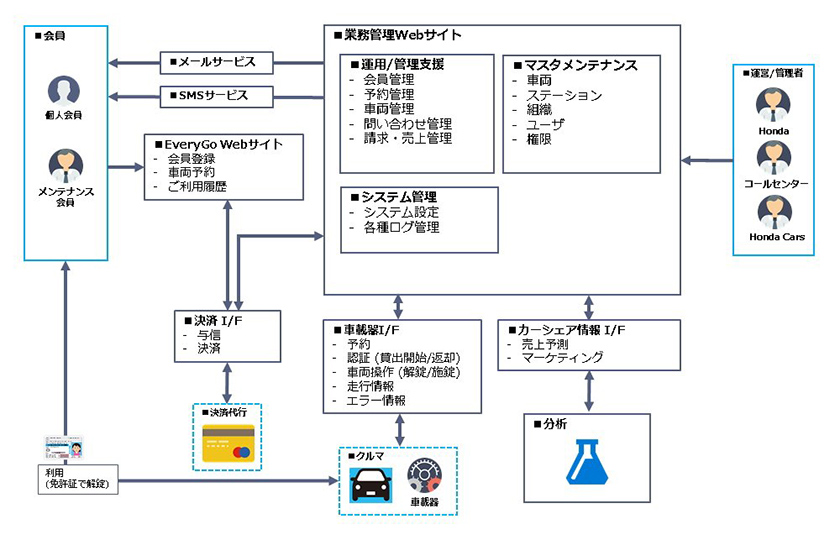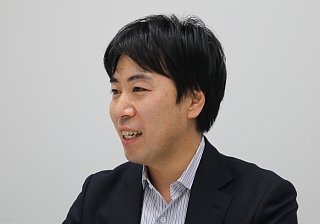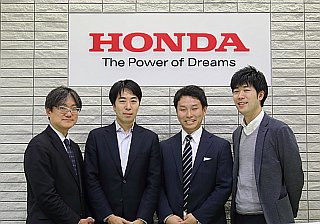Manufacture
Honda Motor Co., Ltd.
The Operational Division and Engineers Coming Together as One Team Focusing on Business Goals. Implementing an Optimal Car Sharing Service through Agile Development

Honda Motor Co., Ltd. (hereinafter “Honda”) is not only an automobile manufacturer, it also develops motorcycles, aircraft, general purpose engines for construction machinery and agricultural machinery, etc., on a global scale. In renewing its car sharing service, Honda built a service platform that maximized the merits of cloud computing through an agile development approach. Developing diverse services and functions, Honda strengthened its relationships with its customers while realizing a system infrastructure that can respond flexibly to additions and changes to functions and services.

(From left) Honda Motor Co., Ltd. Takashi Senoo; Masato Inaba
[System Overview]
Rebuilding the Business System in Step with the Renewal of the Car Sharing Service
Please give us an overview of the system that was built with JBS support.
Honda has been piloting a car sharing service business since 2013. From November 2017 we moved to expand the business under the name EveryGo, and at the same time completely overhauling the service and business infrastructure. Currently, the service is operating mainly in the urban centers of Tokyo, Yokohama, and Osaka. In starting EveryGo anew, we took a fresh look at the operational system and asked JBS to develop and operate the system.
Please tell us about EveryGo.
EveryGo is a service that combines a traditional car rental service with the characteristic convenience of car sharing, which allows you to rent a car with ease. It goes without saying that we hope to provide users with new ways of using and enjoying cars, but as car ownership in urban areas continues to fall, we also want to increase Honda fans by providing opportunities for users to try Honda cars easily and become familiar with them. It is also an important mission to make sure that when a user someday needs a car, they are reminded of Honda.

EveryGo website
The main characteristics of EveryGo are as follows.
- While renting for a long period of time is the premise for car rentals, EveryGo is a new style combining the convenience of car sharing that allows users to reserve a car online whenever they want and take it from an unmanned station.
- The base fee is reasonable and by using the car for eight hours, it allows users to thoroughly experience Honda cars with ease.
- An IC-embedded driver’s license is used in lieu of a membership card. It makes a dedicated membership card unnecessary and touching the IC-embedded driver’s license to a device mounted on the reserved car unlocks it.
- The line-up includes Honda vehicles for various uses with a focus on high grade vehicles with extensive features. The service provides opportunities to experience Honda’s latest vehicle products and technologies.
- By setting up unmanned stations in Honda Car stores (official Honda dealers) in the area and coin-operated parking lots, we are developing an environment in which more and more people can use the service with ease.
Please give us an overview of the business operation system.
The system can be divided into the EveryGo site that is used by customers and the business management
website. The necessary functions and data are aggregated to a common service platform built on Microsoft
Azure (hereinafter “Azure”), which allows the persons in charge of business operation at
each company, such as Honda Cars which handles business operations, the call center which handles back
office administration, vehicle maintenance companies, and others, to access the necessary data when they
need it and in the necessary format.
The necessary functions and services for respective operations are developed as packages on the service
platform and by maintaining loosely-coupled relationships between the packages, it has the scalability
to respond flexibly to changes in the business environment and needs.
Diagram of Features

User Display

[Background to Implementation]
Adoption of a Service Platform with Flexible Functions in Order to Realize Customer-Oriented Innovation
What was the aim of building such a service platform?
Contrary to the technology-oriented innovation of providing excellent products in large volumes at low prices that Honda had been undertaking up until now, the car sharing business demands customer-oriented innovation to provide fun and convenient experiences.
In other words, it is necessary to strengthen our relationships with customers who become members, while at the same time observing usage trends and exploring potential needs that customers themselves may not have even noticed to expand our product and service line-ups.
Additionally, at the Fleet Sales Department we do not handle all of the business operations. We operate the business as an integrated team with Honda Cars and multiple other companies and organizations. On top of that, it is necessary for the structure to be able to respond flexibly to organizational changes, such as the increase or decentralization of the roles and operations of each company and transfer of authority, which accompany the expansion of business and evolution of services.
However, if the system specifications and functions are rigidly fixed from the beginning as in traditional development (waterfall development), it makes flexible response to service changes and expansion difficult and the system becomes inflexible with time, creating the risk of a business bottleneck.
In order to resolve such potential risks in traditional systems and realized a scalable system environment that can respond flexibly to business changes, JBS proposed building a cloud-based service platform and agile development approach.

Honda Motor Co., Ltd. Takashi Senoo
[Reason for Selection]
Expectations for a Partnership with JBS with Extensive Experience in Operational System Development on Azure
What was the reason you adopted the proposal by JBS?

Honda Motor Co., Ltd. Masato Inaba
Our role in the car sharing business is to provide the resources necessary for business operation as packages. Selecting a partner to handle the building, operation, and additional development of the system was also one of our important missions.
So we were not simply looking for a vendor to build a system as instructed, but a business partner who would participate in the car sharing business. Additionally, familiarity with system development on Azure was an absolute condition.
As a Microsoft Gold Cloud Competency Partner, JBS had extensive experience in development on Azure and in terms of technology and track record, they were the ideal partner. Additionally, JBS showed a proactive attitude as a joint project business partner.
With regard to the specific contents of the proposal as well, JBS showed a good understanding of the business and had excellent analytical capabilities to draw out system requirements from the business requirements. With this proposal for an agile development approach that allows system-building while changing or adding functions, we anticipated the realization of highly scalable functions and a service platform that were close to ideal.
What was the reason you adopted Azure?
We had come to the conclusion in a pre-investigation that we would have to use cloud infrastructure that would allow us to launch system operations in line with the scale of business and flexibly expand the scale while curbing the initial infrastructure introduction costs.
Additionally, with regard to the selection of the cloud service, we decided on Azure after determining that expansion using AI would likely be relatively easy because it is highly reliable in running the operational system and a wide range of functions and resources are provided.
[Impact]
Implementing Functions and Services as Desired While Deepening Mutual Understanding between Users and Developers
Did you have any concerns in advancing development with an agile approach?
We had expectations for the new approach, but it was not as if we did not have any concerns as it was a development approach with which we had no previous experience. I can laugh about it now, but I remember being very surprised in the first development cycle that the only thing that moved in the product that had been created was the login screen.
Additionally, because the delivery concept differed from the conventional concept, there were more than a few times when detailed communication was needed regarding the service agreement, etc., between the persons in charge on both sides.
However, once actual development started, the JBS engineers and the staff on the Honda side who were involved in operations were able to exchange opinions directly, check the system’s ease of use, and evolve the functions and services. This fostered a natural sense of unity between team members and I became convinced that this system development would go well.
With the conventional development approach to date, steps included the business division deciding on the function specifications while taking into consideration the advice of consultants, then incorporating them into the system specifications, with the internal division in charge developing the system with support from external vendors, and checking the functions. This led to low technological understanding on site and low business understanding on the development side. Without being able to actively exchange opinions, there were times when we could not realize functions the way we envisaged them. Additionally, once function requirements were decided, it was not easy to change them, nor was it easy to add functions midway.
This time, we were able to test things immediately during the development process if ideas or opinions came up and we were able to repeat the PDCA cycle incrementally. Even if changes or additions came up, a development cycle emerged for all the members to come together to explore methods to resolve the changes or additions, leading to the elimination of negative compromises and ambiguity.
[Development Going Forward]
Considering Use Not Only for Enhancement of the Operational System, but Also as a PoC Platform
Is there anything you can tell us about future development plans?
Nothing concrete has been decided, but we are thinking about enhancing services and functions such as developing services for corporate use or for housing complexes. On the system front, it has become easier to add services and functions, so we will undertake development while determining needs and impact.
Furthermore, as a part of proof of concept (PoC) we hope to analyze usage trends and future projections using Azure AI, etc., and try to create a system that gives feedback to the car sharing business functions and services as well as to those in charge of product development.
[Assessment]
Outstanding Logical Proposals with High Viability
What is your assessment of JBS?
JBS provides consistent one-stop support from consulting when deciding the operational requirements, deciding the system specifications, developing and installing the program, to maintenance and operation. Because JBS accurately understands the business content, there is no contradiction or break in logic and their service is always based on sound and viable proposals. I was very impressed by their work.
Additionally, JBS has experienced specialists and engineers in every field regardless of age who exchange frank opinions and ideas with each other. This created an atmosphere for the staff on the Honda side to be able to voice their ideas and opinions without becoming overwhelmed as well. I am grateful for that.
[Comments from the JBS Side]
Nowadays as everyone is shifting toward cloud computing and digitalization and IT strategies are becoming indispensable to business strategies in every industry, I felt that to be able to advance a project with the business division and external vendors working as one team was as meaningful as the product that was created. I hope to maintain this culture of interaction on this project and provide even better experiences to users, always remaining aware that we too are providers of the car sharing service. (Kitamura)
For JBS, which has mainly provided support to Honda in the communications infrastructure domain up to now, developing a system for consumers was a major challenge. I think that it is thanks to each company overcoming internal barriers and working together as one team to create the system that led to this outcome. I hope to continue to work as an innovation partner who can think about business along with Honda so that the car sharing business becomes an even better part of people’s lives in the future. (Koketsu)

(From right) Japan Business Systems, Inc. Wataru Kitamura, Kazuma Koketsu
Honda Motor Co., Ltd.
Representative: President and Representative Director Takahiro Hachigo
Head Office: 2-1-1, Minami-Aoyama, Minato-ku, Tokyo
Established: September 24, 1948
Capital: 86 billion yen (as of March 31, 2017)
No. of employees: Consolidated basis: 211,915 persons Non-consolidated basis: 21,903 persons (as of March 31, 2017)
Main Business Activities: Production and sales of automobiles, motorcycles, and power products
- The contents of this interview are all as of the time of the interview. The names of companies, departments, products, etc., appearing in the case study may differ as of the time of reading.
Published: 2018.03.29
- Related Tag
 Share
Share